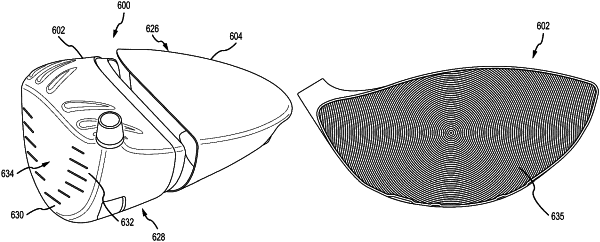| CPC A63B 53/0466 (2013.01) [A63B 53/0408 (2020.08); A63B 53/042 (2020.08); A63B 53/0445 (2020.08)] | 18 Claims |

|
10. A golf club head comprising:
a front body and a rear body that cooperate to define a hollow internal club head volume;
wherein the front body comprises a strike plate and a frame integrally formed with each other to form a cup face; the strike plate further comprising a ball striking surface having a striking surface texture characteristic of milling and a back surface having a back surface texture characteristic of milling;
wherein the back surface is milled and machined to adjust at least one of: a thickness of the ball striking surface, a bulge radius of the ball striking surface, or a roll radius of the ball striking surface;
wherein the cup face extends rearward to form a portion of a crown and a sole;
wherein the strike plate is disposed at a loft angle of from 8 degrees to 24 degrees;
the striking surface texture is uniform across the strike plate when measured in a predominant milling pattern direction and comprises a plurality of peaks, a plurality of valleys, and a reference mid-plane extending in between the plurality of peaks and the plurality of valleys, wherein below the reference mid-plane is a negative distance, and above the reference mid-plane is a positive distance, and the plurality of peaks and the plurality of valleys extend an average maximum distance of at least −200 micro inches (−5.08 micro meters) to at least 200 micro inches (5.08 micro meters);
the surface texture further comprises a central portion that is surrounded by a peripheral portion;
the central portion comprises a concentric milling pattern extending in a first predominant pattern direction;
the peripheral portion comprises a linear milling pattern extending in a second predominant pattern direction;
the surface texture further comprises an average surface roughness (RA), representing an arithmetic average value of absolute surface deviations relative to a mean center line, a surface void parameter (WVoid), representing an average depth of the plurality of valleys relative to a closed reference surface created using a morphologic closing filter applied to the surface texture, and a surface contact parameter (WVDCL), representing the amount of contact between the closed reference surface and the surface texture; and
wherein the striking surface texture, measured within at least one of a vertical cutting plane or a second cutting plane that is orthogonal to both the vertical cutting plane and the ball striking surface, is characterized by at least one of: a ratio of RA to WVoid being greater than about 4; or, a WVDCL parameter being greater than about 24%; and
wherein the striking surface texture and the back surface texture are identical.
|